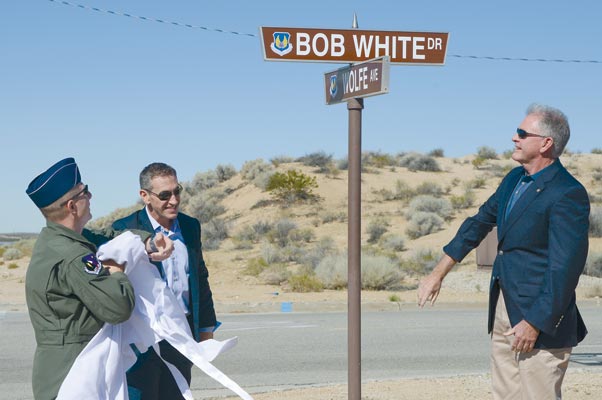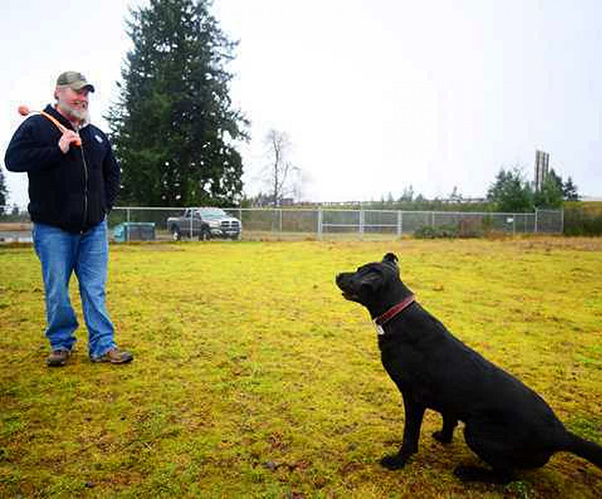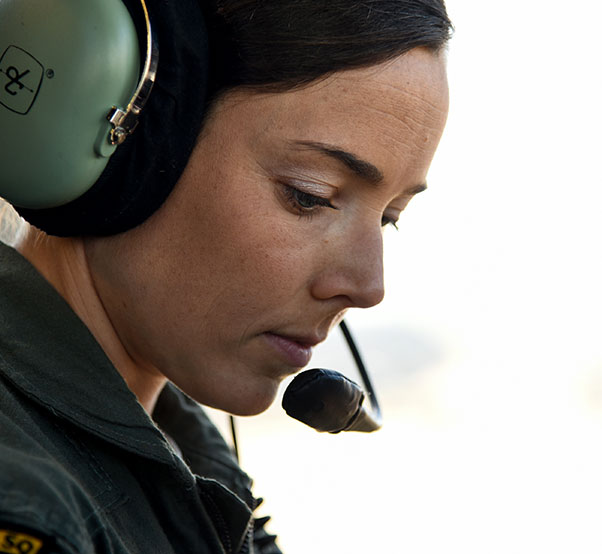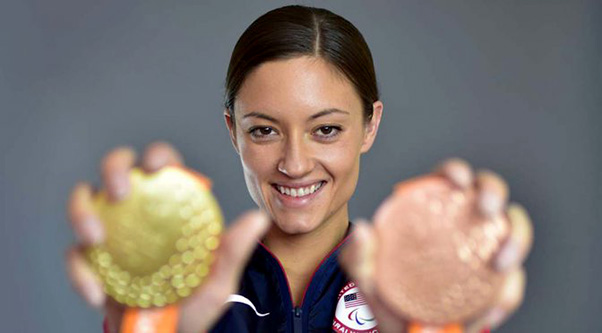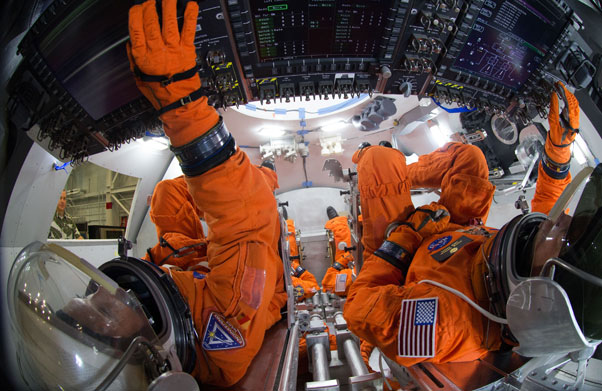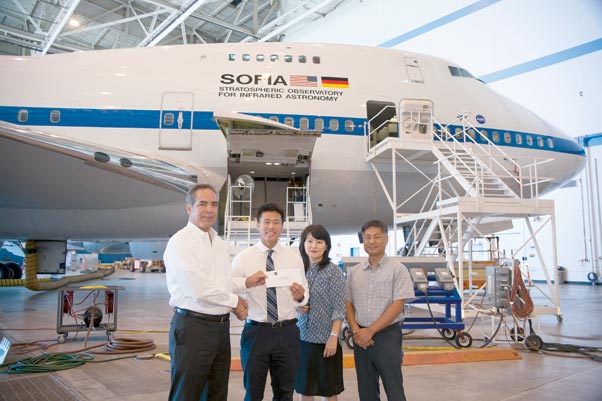On Aug. 7, at the intersection of Wolfe Ave. and South Muroc Dr., a street dedication ceremony was held in honor of X-51 pilot, Maj. Gen. Robert M. White.
With Brig. Gen. Carl Schaefer, 412th Test Wing commander presiding, the street formerly known by the name Muroc was renamed Bob White Drive.
In attendance were White’s sons, Greg and Dennis, along with his friends Johnny Armstrong, Al Hallonquist, Bob Hoey and Michelle Merril.
“I’ve heard some people describe my dad as a reluctant hero, but his humility wasn’t born out of fear of the spotlight,” said Dennis White. “What it came from was an insistence that he would never single-handedly take credit for the hard work that an entire team delivered. The willingness and the discipline to be a part of something bigger than yourself, that’s what Bob White Dr. means to me.”
Greg White remembers his father as a “great American” who taught him stick-to-itiveness and discipline. Growing up with their sisters, Pamela and Maureen, the Whites found themselves members of a much bigger family—their Air Force family.
“These people have been in combat together, they’ve tested together, they’ve risked their lives together, there’s a bond there and it extends to the families; you just feel it,” remembered Greg. “Right now I feel that sense of ‘this is my family, these people care about you.’”
White served in the U.S. Air Force from 1942 to 1981. During that time he flew the F-86, F-89, F-102, F-105, X-15 and more.
Then Second Lieutenant Lt. White was commissioned as a World War II P-51 pilot in 1942. He was shot down following his 52nd combat mission in February of 1945 and was held as a prisoner of war until his release that April.
Six years later he was recalled as a troop carrier pilot at Mitchell Air Force Base, N.Y., during the Korean War. From 1952 to 1953, he served in the 40th Interceptor Squadron at Johnson Air Force Base, Japan. From there he went to work at the Rome Air Development Center, N.Y., as an engineer before coming to the U.S. Air Force Test Pilot School here in 1954.
One year later he graduated and went on to test the F-86, F-89, F-102, F-105 and in 1958 he was designated an X-15 test pilot.
The X-15 was tested jointly by NASA and the Air Force. Each entity assigned one pilot and one flight planner. Hoey worked with White as the Air Force flight planner for the X-15 project, as well as on many other test projects. As a stability and control engineer, Hoey had a unique opportunity to see how pilots fly their airplanes.
According to him, most fighter pilots are “quite aggressive” in the way they fly.
“Bob was not like that, he was very smooth, he could nudge the airplane and very carefully put it exactly where he wanted it to be. He was a super test pilot, an excellent test pilot,” recalled Hoey.
In the X-15, White was the first person ever to fly Mach 4, Mach 5 and Mach 6. He received his astronaut wings in 1962 after flying at an altitude of 314,750 feet (59 miles) above the Earth.
“At this point he finished his career at Edwards and went on to become the Air Force Flight Test Center commander—at least that’s what I thought,” said Schaefer. “I was blown away to find out that he went back to the operational world in 1963 to fly F-105s in Bitburg, Germany.”
White was a fighter pilot “to his core.” In 1965 he went into the F-111 System Program Office at Wright Patterson AFB, Ohio, only to go back into combat two years later.
He completed 70 combat missions in the F-105 with the 355th Tactical Fighter Wing in Vietnam and was awarded the Air Force Cross for leading a mission to destroy the Paul Doumer Bridge in Hanoi.
“So what do you do with a combat-decorated, national asset test pilot? You make him director of the F-15 Program Office back at Wright Patterson,” said Schaefer.
He went on to say that White was the perfect fit for the job and the reason that the F-15 is still dominating the skies today.
In 1970, White assumed command of the then AFFTC where he was responsible for testing the F-15, the A-10 and the Airbore Warning and Control System, better known as AWACS. All of which are still performing combat operations today.
In 1971 he completed the Naval Test Parachutist Course and was awarded his jump wings. After his command tour he served nine more years training new officers and went back to operations until he retired as a major general in 1981.
“Dennis and Greg, your dad is my hero … I was prepared to honor a flight test hero today and I was blown away by the entirety of his service,” said Schaefer. “Your dad’s story connected me to him in a way that’s hard to describe. Although he didn’t know it, General White helped me fulfill my dream of becoming an F-15 pilot and his efforts kept me and countless others safe in combat.”
Bob White Drive’s cross street, Wolfe Ave., is named after Capt. Joseph Wolfe, who died in 1951 testing the B-47 at Edwards when he and his team crashed on take-off.
According to Dennis, the last plane White ever flew was at Edwards, and after that, he never had an interest in flying again.
“Some would say it’s because Cessna’s don’t have afterburners,” Dennis joked, adding that he has a very different theory on the matter.
“[After leaving the Air Force] there wasn’t a mission, there wasn’t a squadron. He wouldn’t have been a member of the U.S. Air Force and that to him was everything. That was his identity. He called it his second family.”
At the end of the ceremony, Dennis shared a special memory of his father, which gave him insight into what made him who he was.
“I was quizzing him one afternoon, like I had done a hundred times, trying to get out of him what it was like for him to have made his way to Edwards AFB and be a part of the golden age of flight. As usual he’s giving me nothing. Zero inspiration—just-matter-of-fact answers,” recalled Dennis.
Dennis would ask things like “Why did you want to come to Edwards?” And, “How did you get into the test pilot school?” White would reply, “I filled out an application, command accepted it.”
“After some back and forth, he looks at me and says, ‘You want to know why? Because I wanted to fly all of them. And I did.’”


